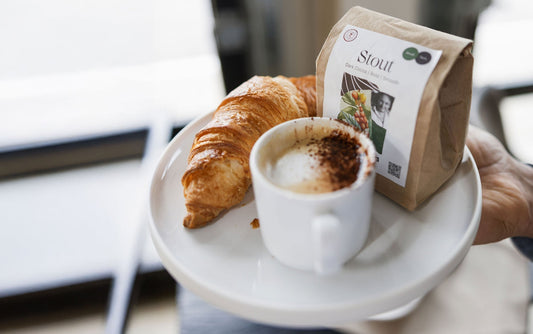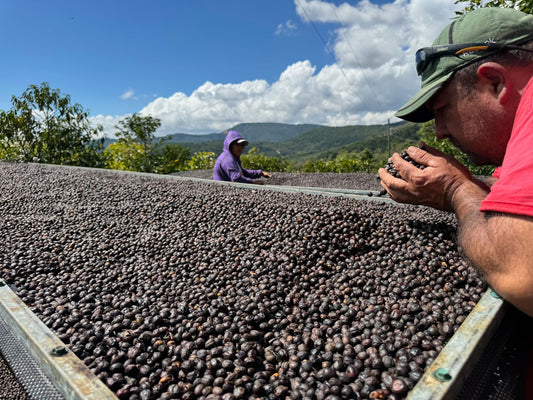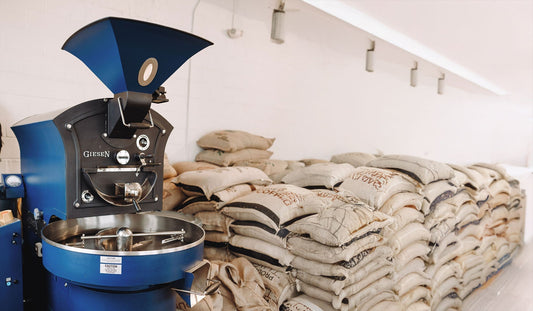We often get asked about the difference between cold brew and iced coffee. You’d be forgiven for assuming that they’re the same due to the implied coldness, but they’re actually two very distinct coffee drinks with their own unique preparation methods and flavor profiles.
The quick answer: Cold brew is a brewing method; iced coffee is a type of drink. Cold brew coffee is usually served cold, so it can be iced coffee, but it can also be served hot. Iced coffee, unsurprisingly, is always served cold. However, the coffee used to make iced coffee often starts as traditional hot coffee before being chilled.
Confused? Don’t worry! We’re going to break down cold brew vs. iced coffee in a way that’s easily digestible. Let’s get started!
Cold Brew vs. Hot Brew
Cold brew and hot brew refer to two different preparation methods:
- Cold Brew: Cold brew is when coffee is steeped in cold or room-temperature water for a long time, typically 12-24 hours.
- Hot Brew: Hot brew is when coffee grounds are steeped in hot water. This can be accomplished in a number of ways, including French presses, drip machines, espresso machines, and pouring hot water over coffee grounds in a filter.
Both of these methods extract rich coffee flavor from the beans into the water, but cold brew uses time and hot brew uses heat.
Cold Brew vs. Iced Coffee: The Basics

Now that you understand the difference between cold and hot brewing, let’s talk about the difference between cold brew and iced coffee. In short, iced coffee can refer to any type of coffee that’s served over ice, regardless of how the coffee was originally brewed. In other words, any type of coffee becomes iced coffee if you serve it iced!
Cold brew coffee is usually served cold, but plenty of coffee enthusiasts enjoy it heated up, too. On the other hand, if you order an iced coffee, you know exactly what to expect.
Cold Brew vs. Iced Coffee: Tasting Notes
The flavor profile of coffee beans depends on many factors, including their coffee bean variety, the coffee-growing region from which they originated, the terroir in which they were grown, harvesting and processing techniques and rituals, and their roasting style and level; and that’s all before the brewing even begins!
As you might expect, how the coffee beans are brewed also affects the flavor of the finished drink. To keep things simple, we’re going to compare cold brew vs. hot brew methods. Here’s a quick breakdown of the typical flavor profiles of cold brew vs. iced coffee, under the assumption that the iced coffee has been brewed through a traditional hot brew method.
- Cold Brew: Cold brew coffee tends to be mellower and smoother because less of the beans’ acidic compounds are extracted into the water. There are often sweet undertones and notes of caramel, chocolate, and nuts (although tasting notes can vary widely depending on the beans).
- Iced Coffee (Hot Brew): Iced coffee that has been prepared with one of the hot brew methods is typically brighter, more acidic, and in some cases, more bitter. This is because the heat extracts more of the coffee beans’ natural acidic compounds.
In summary, when it comes to cold brew vs. iced coffee, cold brew has a distinct taste that’s mellower and sweeter; iced coffee generally has the classic coffee flavor you’re accustomed to, with the only difference being that it’s served cold over ice.
If you prefer a mellow-flavored iced coffee, go for the cold brew.
Caffeine Content
Now that you’re familiar with both drinks’ preparation methods and typical flavor profiles, let’s talk about the caffeine difference between cold brew and iced coffee.
Because cold brew coffee is steeped for so long, more caffeine is extracted. And, typically cold brew coffee uses more beans, further increasing the amount of caffeine.
So, if you’re stuck choosing between cold brew vs. iced coffee for your morning pick-me-up, the cold brew will usually deliver a stronger jolt. In general, a 16-ounce cup of cold brew will typically have around 200 mg of caffeine compared to 100-150 mg in a hot brew. That said, the preparation method is just one of the many factors that contribute to the caffeine content of a drink.
Which Drink Should You Choose?

We recommend trying both drinks to determine which is the best fit for you. There’s no right or wrong answer when it comes to matters of preference! Here’s a quick overview to point you in the right direction as you choose between cold brew vs. iced coffee:
When to Choose Cold Brew:
- You’re in the mood for a mellow, smooth coffee.
- You want an extra caffeine boost.
- You have a sensitive stomach.
- You want something a little fancier.
- You appreciate the craft and artistry of brewing coffee.
When to Choose Iced Coffee:
- You’re in the mood for a classic, familiar coffee, only cold.
- You want the standard amount of caffeine.
- You want something budget-friendly.
Coffees That Pair Well:
- Ethiopia Inya coffee beans - pineapple, marmalade, and hoppy undertones
- Costa Rica Sañeri coffee beans - berries, dried plum, and nuanced notes
- Brazil Stout coffee beans - bold, smooth, dark cocoa notes
Experience Farm-to-Cup Coffee
As you can see, there are major differences between cold brew and iced coffee. To simplify your decision, start by choosing between cold brew vs. hot brew coffee. Once you’re able to distinguish between both brewing methods, you can more accurately decide between cold brew vs. iced coffee.
Regardless of how you like your coffee prepared, starting with high-quality specialty coffee beans is a must. At Ebru Coffee, we proudly offer some of the world’s finest single-origin coffees that are ethically and sustainably sourced from all around the globe. However you brew them, you’re in for a treat. Shop now to find your new favorite coffee!





